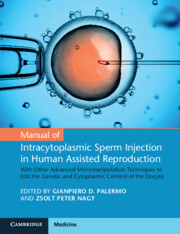 Manual of Intracytoplasmic Sperm Injection in Human Assisted Reproduction
Manual of Intracytoplasmic Sperm Injection in Human Assisted Reproduction Published online by Cambridge University Press: 02 December 2021
Conventional IVF insemination has been providing satisfactory results in most cases in absence of male-factor infertility. However, low fertilization or complete fertilization failure can happen not only when sperm parameters are impaired but occasionally also when there is no detected male factor. In these occasions, to rescue the IVF treatment cycle, ICSI re-insemination of the failed-fertilized oocytes (after the original conventional insemination) may be attempted. Oocyte aging plays an important role, as because fertilization check is usually performed 16–18 hours after conventional insemination, when failure of fertilization can be detected, however, by that time outcomes after rescue ICSI is mostly suboptimal, if attempted. Alternatively, conventionally inseminated oocytes can be examined much sooner to detect signs of fertilization. It has been demonstrated, if oocytes are submitted to rescue ICSI within 4–8 hours after the initial insemination, then laboratory and clinical outcomes are significantly improved. Since conventional IVF insemination remains to be used frequently around the world, adequately performed rescue ICSI is a viable option to save IVF treatment cycles when unexpected low or total fertilization failure occur.
To save this book to your Kindle, first ensure [email protected] is added to your Approved Personal Document E-mail List under your Personal Document Settings on the Manage Your Content and Devices page of your Amazon account. Then enter the ‘name’ part of your Kindle email address below. Find out more about saving to your Kindle.
Note you can select to save to either the @free.kindle.com or @kindle.com variations. ‘@free.kindle.com’ emails are free but can only be saved to your device when it is connected to wi-fi. ‘@kindle.com’ emails can be delivered even when you are not connected to wi-fi, but note that service fees apply.
Find out more about the Kindle Personal Document Service.
To save content items to your account, please confirm that you agree to abide by our usage policies. If this is the first time you use this feature, you will be asked to authorise Cambridge Core to connect with your account. Find out more about saving content to Dropbox.
To save content items to your account, please confirm that you agree to abide by our usage policies. If this is the first time you use this feature, you will be asked to authorise Cambridge Core to connect with your account. Find out more about saving content to Google Drive.